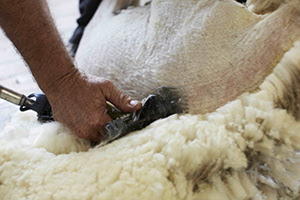
More wool to be shorn next year
MORE sheep producers retaining ewes is underpinning a predicted wool production increase in all states except Victoria and Tasmania next year.
And Queensland is forecast to have the biggest clip increase of 15 percent in 2016-17, the Australian Wool Production Forecasting Committee said today.
The committee has forecast shorn wool production to lift by 2.2 percent nationally to 332 mkg greasy in 2016/17.
A 2.7pc increase in average wool cut per head, due to excellent season conditions and an abundance of feed, is expected to offset the small decline expected in sheep shorn.
Click here to get Sheep Central story links sent to your email inbox.
The committee’s final estimate of shorn wool production for 2015/16 at 325 mkg, 6.2pc below the 2014/15 production level.
Committee chairman Russell Pattinson said Meat & Livestock Australia and Australian Wool Innovation wool and sheepmeat survey results indicated that producer intent to maintain or increase ewe numbers is as high as its been for 2-3 years.
“Our view is that a lot of people will be hanging onto sheep, that’s why we think sheep shorn numbers will increase, so there is a bit of a more positive feeling than there has been for some time.”
Queensland turnaround due to return of agisted sheep
Mr Pattison said although the opening sheep numbers for Queensland were down, the state committee believes the number of sheep shorn this season will go up by 3.6pc, due mostly to sheep returning from agistment with the improvement in seasonal conditions. An expected increase in Queensland wool cut by 11pc is also contributing to the forecast 15pc in wool production. The state breakdown of flock changes will detailed in a report due out next week.
Mr Pattinson said almost all major sheep producing areas across Australia are reported to be experiencing very good to excellent season conditions and an abundance of feed after a very wet Spring. This is expected to result in even better average wool cuts per head in 2016/17 than the committee anticipated in August.
“Some regions, notably in Victoria, in the Tablelands of New South Wales and in Tasmania, have experienced a rather tough winter after seeing very dry conditions up until May, so fleece weights are only now starting to improve. The full benefit of the improved seasons is expected to be seen during autumn shearing. Elsewhere it seems that fleece weights have already improved and this should continue as the season progresses.
“The interesting part for us will be some of the figure we see in Autumn – we meet again in April and we will have a far better idea of whether those weights pick up as we expect.”
Average clip micron to hold steady at 20.7 micron
The committee predicts that shorn wool production will increase in New South Wales, Western Australia, South Australia and Queensland. The increase in Queensland is particularly welcome after three consecutive years of declines and in part reflects sheep returning to the state after the breaking of the long drought. Production in Victoria is expected to be steady, with an improvement in the second half of the season while production in Tasmania is predicted to be slightly lower.
The AWPFC’s final estimate of shorn wool production for the 2015/16 season of 325 mkg, a decline of 6.2pc over the 2014/15 previous season, is as noted in August, in line with, but less than, the decline in the weight of wool tested by AWTA for 2015/16. This difference arises as some of the increase in wool tests, receivals and auction offerings late in the 2014/15 season was due to the release of on-farm stocks. This stock was not available for sale in 2015/16.
The committee noted that for the 2016/17 season to November, the AWTA test data showed a significant decline in the weight of wool tested between 16.6 to 18.5 micron and wool broader than 26.5 micron. There was an increase in the volumes of wool for all micron ranges between 18.6 micron and 23.5 micron. The mean fibre diameter for Australia in 2016/17 to November was 20.7 microns, the same as in 2015/16.
Click here for wool production forecast details.
Click here for wool production details by state.
Click here to see results of the October 2016 MLA/AWI Wool and Sheepmeat Survey.
Source: AWI.



HAVE YOUR SAY